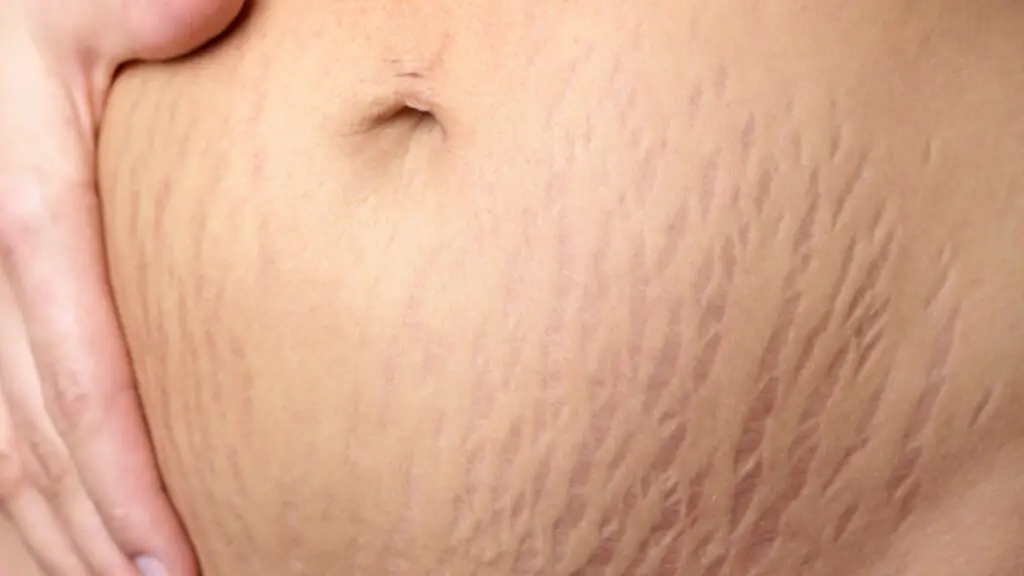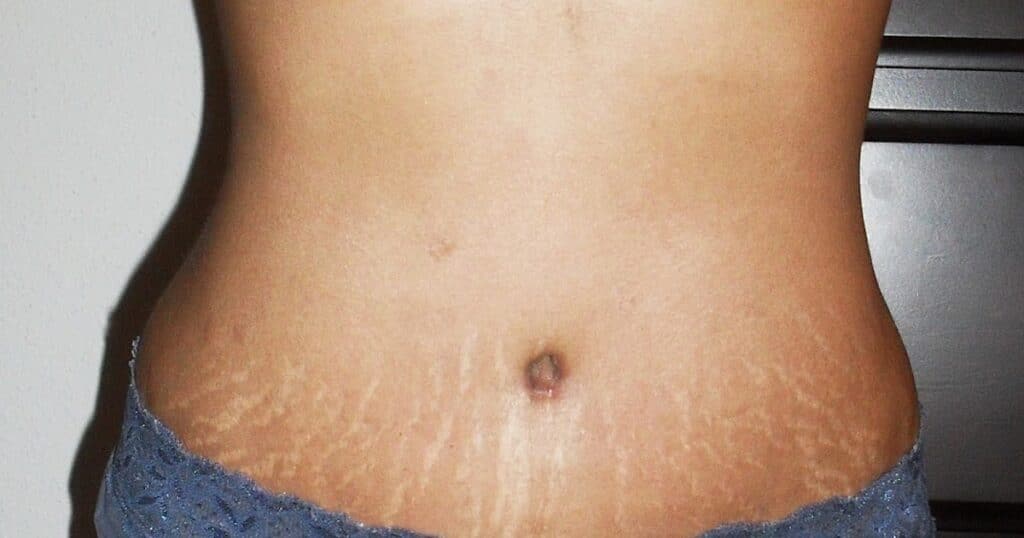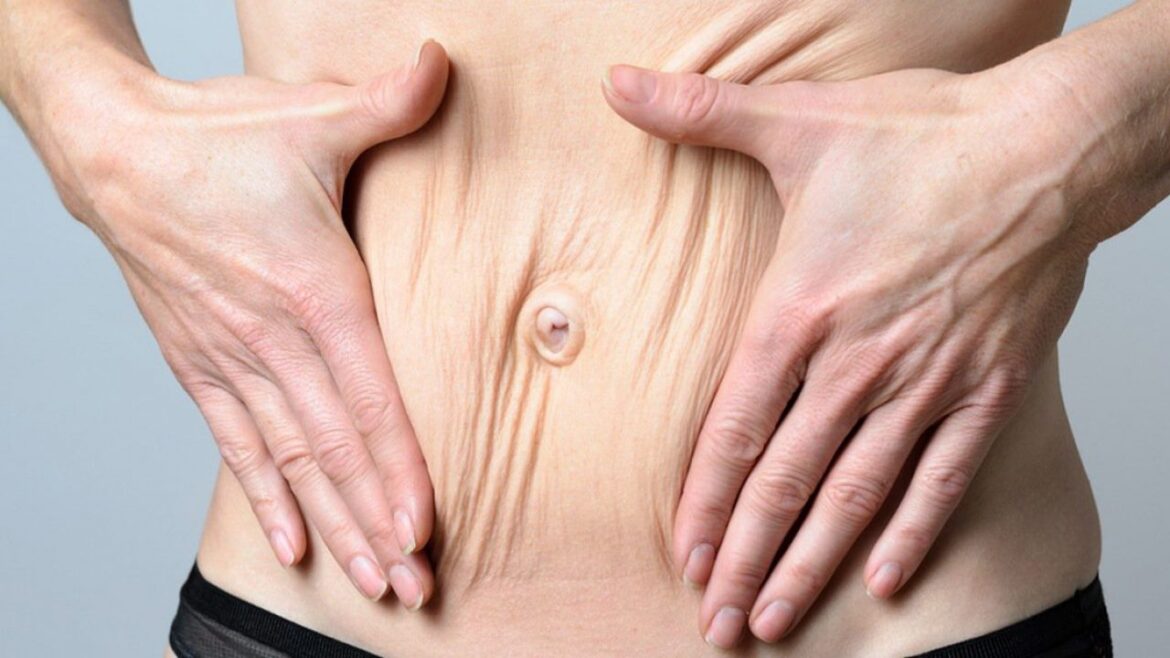Introduction
What Do Stretch Marks Look Like After Weight Loss: Stretch marks are a common skin concern that many individuals face, and their appearance can change significantly after weight loss. These marks, also known as striae, often develop when the skin stretches rapidly due to factors like pregnancy, growth spurts, or weight gain. However, they don’t discriminate – weight loss can also bring about changes in the way stretch marks look.
The transformation of stretch marks after weight loss can be a source of curiosity and concern for those on a weight loss journey. As the body sheds pounds, the skin, which once accommodated the extra weight, begins to contract. This contraction process can have various effects on the appearance of stretch marks, such as alterations in color, texture, and prominence. Understanding the evolution of these marks post weight loss informs and supports body image and self-esteem.
Explore the world of stretch marks, their transformation post-weight loss, and how to manage and embrace these changes. Stretch marks, scientifically called striae distensae, occur when the skin can’t keep up with rapid size changes. They often begin as reddish or purple streaks, which is indicative of their initial inflammation. However, as time progresses and they mature, their appearance evolves.

What do stretch marks look like after weight loss?
A disruption to the collagen and connective tissues can cause stretch marks after weight loss and weight gain. And, as a result, stretch marks typically appear purple and blue [5]. These stretch marks tend to fade over time to a lighter skin colour. After weight loss, the appearance of stretch marks can undergo several noticeable changes. Initially, stretch marks often appear as purplish or bluish streaks on the skin’s surface. The color change occurs due to the initial stretching, which can damage collagen and connective tissues in the skin. The inflammation and microtears in the skin lead to the purple or blue hue of stretch marks.
As the skin adapts to the smaller body size, these marks transform, fading to match your skin tone. This happens as blood vessels in the area constrict, reducing visibility. The end result is often a series of stretch marks that appear as silvery or white lines on the skin.
What do stretch marks look like?
Stretch marks look like lines or streaks across the skin. Stretch marks can be pink, red, brown, black, silver or purple. They usually start off darker and fade over time. Stretch marks, or striae, commonly appear on the tummy, breasts, chest, upper arms, legs, bottom, hips, or back, displaying distinct lines or streaks with varying colors based on their stage of development.
Here are some common characteristics of stretch marks:
Color: Stretch marks can appear in a range of colors, including pink, red, brown, black, silver, or purple. The initial coloration is often brighter, such as pink or red, and gradually fades over time. Mature stretch marks tend to be silvery or white.
Texture: In their early stages, stretch marks may feel slightly raised or have a textured surface. As they mature, they often flatten out and become smoother, although the texture can still differ from the surrounding skin.
Location: Stretch marks are most common on areas prone to rapid skin stretching. These areas include the tummy, breasts, chest, upper arms, thighs, buttocks, hips, and lower back.
Length and Width: Stretch marks’ length and width vary based on skin stretching and individual factors. They may appear as short, thin lines or longer, wider streaks.
Arrangement: Stretch marks can be closely spaced or widely scattered. They often appear in parallel lines or in a branching pattern, resembling tree branches or lightning bolts.
Do red stretch marks mean weight loss?
Rapid weight gain places pressure on your skin, forcing it to stretch to accommodate the increased body mass. Depending on where you gain excess pounds, red stretch marks could appear anywhere on the body. Red stretch marks can appear for various reasons, not just due to weight changes. They typically form when the skin rapidly stretches, whether from weight gain or loss.
Here’s how red stretch marks can be associated with both weight gain and weight loss:
Weight Gain: When people gain substantial weight quickly, their skin may struggle to keep up with the rapid expansion. This stretching of the skin can lead to the formation of red or purplish stretch marks. These marks result from the skin responding to increased tension and pressure due to extra body mass.
Weight Loss: Conversely, rapid weight loss can also lead to the appearance of red stretch marks. As the body loses weight, the skin that stretched may not immediately return to its original size. This can make the skin look loose and wrinkled, and red or pink stretch marks may become more visible.
What causes stretch marks?
Stretch marks (striae) result from rapid skin stretching due to factors such as obesity, growth spurts, pregnancy, or conditions like Cushing syndrome. The Stretch marks (striae) can appear when there is rapid stretching of the skin.
Striae, form as the skin can’t keep up with rapid size changes or stretching.
While they can occur for various reasons, the primary causes of stretch marks include:
Rapid Weight Gain or Loss: One of the most common causes of stretch marks is rapid weight change. Rapid weight gain causes the skin to stretch to accommodate the increased body mass. various weight loss can cause stretch marks as the skin contracts and may not immediately adjust to the reduced size.
Puberty: During puberty, adolescents may develop stretch marks as their bodies rapidly grow in height and muscle mass. These marks can appear on various body parts, including the hips, thighs, buttocks, and breasts.
Pregnancy: Pregnant women often develop stretch marks on the abdomen, breasts, and hips as their bodies adapt to the growing fetus. The hormonal fluctuations during pregnancy can also contribute to the formation of stretch marks.
Corticosteroid Use: Excessive use of corticosteroid medications can weaken skin fibers, making it prone to stretching and stretch mark development.
Medical Conditions: Conditions like Cushing’s syndrome and Marfan syndrome can heighten stretch mark risk due to hormonal imbalances and altered connective tissue.
How to reduce stretch marks?
Treatment
Retinoid cream.
Derived from vitamin A, retinoids such as tretinoin (RetinA, Renova, Avita) that you apply to your skin may improve the appearance of stretch marks less than a few months old.
Light and laser therapies.
Microneedling.
Reducing the appearance of stretch marks can be challenging, and complete removal is often not possible. Several treatments can improve the appearance of relatively new stretch marks with red or pink coloration.
Here are some common treatments:
Topical Retinoid Creams: Retinoid creams, like tretinoin (Retin-A), can effectively improve the appearance of new stretch marks. These creams work by stimulating collagen production and increasing skin cell turnover. They are available by prescription and should be used under the guidance of a healthcare professional.
Light and Laser Therapies: Various light and laser therapies, including pulsed dye lasers and fractional lasers, can help reduce the color and texture of stretch marks. These treatments work by promoting collagen production and breaking down the red or purple pigment in the marks. Multiple sessions may be required for optimal results, and it’s essential to consult with a dermatologist to determine the most suitable approach.
Microneedling: Microneedling involves the use of a device with fine needles that create controlled micro-injuries in the skin. This process stimulates collagen production and can help improve the texture and color of stretch marks. Microneedling is typically performed by a dermatologist or skincare professional.
Topical Creams and Oils: Over-the-counter creams and oils containing ingredients like hyaluronic acid, vitamin E, cocoa butter, and shea butter may help hydrate the skin and improve its elasticity. While these products may not eliminate stretch marks, they can make them less noticeable and help prevent new ones from forming.
Prescription Medications: In some cases, a dermatologist may prescribe topical medications, such as corticosteroid creams, to reduce inflammation and itching associated with stretch marks. These creams can help make the marks less red and uncomfortable.
Are red stretch marks good?
Red stretch marks are common and benign. They typically occur when the skin stretches due to the rapid increase in size of underlying structures. Red stretch marks are not harmful. However, some people may wish to treat them or reduce their appearance with topical creams and other therapies.
Topical Retinoid Creams: Retinoid creams, such as tretinoin (Retin-A), can be effective in improving the appearance of stretch marks, especially when they are less than a few months old. These creams work by stimulating collagen production and increasing skin cell turnover. They are available by prescription and should be used under the guidance of a healthcare professional.
Light and Laser Therapies: Various light and laser therapies, including pulsed dye lasers and fractional lasers, can help reduce the color and texture of stretch marks. These treatments work by promoting collagen production and breaking down the red or purple pigment in the marks. Multiple sessions may be required for optimal results, and it’s essential to consult with a dermatologist to determine the most suitable approach.
Microneedling: Microneedling involves the use of a device with fine needles that create controlled micro-injuries in the skin. This process stimulates collagen production and can help improve the texture and color of stretch marks. Microneedling is typically performed by a dermatologist or skincare professional.
Topical Creams and Oils: Over-the-counter creams and oils containing ingredients like hyaluronic acid, vitamin E, cocoa butter, and shea butter may help hydrate the skin and improve its elasticity. While these products may not eliminate stretch marks, they can make them less noticeable and help prevent new ones from forming.
Prescription Medications: In some cases, a dermatologist may prescribe topical medications, such as corticosteroid creams, to reduce inflammation and itching associated with stretch marks. These creams can help make the marks less red and uncomfortable.
Can coconut oil remove stretch marks?
Coconut oil can help you heal the stretch marks quickly. Studies suggest that coconut oil has healing properties and takes less time to heal skin wounds. How to use it: Apply virgin coconut oil on your stretch marks twice every day. Pure aloe vera is not only a good healing agent, but can also make skin smooth.Coconut oil is often promoted as a natural remedy for various skin issues, including stretch marks, due to its moisturizing and skin-nourishing properties. While coconut oil may help improve the appearance of stretch marks and make the skin feel smoother, it’s important to note that it is unlikely to completely remove or eliminate well-established stretch marks, especially those that have turned silvery or white. However, it can be a part of a comprehensive skincare routine to potentially reduce the visibility of newer stretch marks.
Here’s how to use coconut oil for stretch marks:
Choose Virgin Coconut Oil: Opt for high-quality, virgin coconut oil as it contains more of the beneficial compounds found in coconuts.
Cleanse the Affected Area: Before applying coconut oil, clean and gently exfoliate the area with warm water and a mild exfoliating scrub or a soft washcloth to remove dead skin cells.
Apply Coconut Oil: Take a small amount of coconut oil and massage it onto the stretch marks in a circular motion. Ensure that the oil is well-absorbed by the skin.
Repeat Regularly: Apply coconut oil to the affected area at least twice a day, ideally in the morning and before bedtime.
Combine with Aloe Vera: As mentioned in your question, you can also consider using pure aloe vera in conjunction with coconut oil. Aloe vera is known for its skin-soothing and healing properties. Apply pure aloe vera gel to your stretch marks after applying coconut oil for added benefits.
Are stretch marks permanent?
They Don’t Go Away. Like any other scars, stretch marks are permanent. Over time, they typically fade and may appear white or silvery, lighter than the rest of your skin. If you feel self-conscious about them, remember, more than half of adults have them.Stretch marks are generally considered permanent, and like other scars, they do not completely disappear. However, their appearance can change over time, and they tend to become less noticeable.
Here are some key points about the permanence of stretch marks:
Fading: Stretch marks often start as reddish or purplish streaks on the skin, which is indicative of recent stretching and inflammation. Over time, typically several months to years, they tend to fade and become lighter in color. Mature stretch marks often appear as silvery or white lines that are closer in color to the surrounding skin.
Texture: While the color of stretch marks can change, their texture can also evolve. In their early stages, stretch marks may feel slightly raised or have a textured surface. As they mature, they often flatten out and become smoother, although the texture may still differ from the surrounding skin.
Visibility: Stretch marks may not vanish entirely but become less noticeable as they fade and blend with the skin tone. Their visibility can also be influenced by factors such as lighting and skin hydration.
Treatment Options: Treatments like topical creams, laser therapy, and microneedling can improve new stretch marks with red or pink coloration. These treatments can help reduce redness, smooth the skin, and promote collagen production.
Acceptance: It’s important to recognize that stretch marks are a natural and common part of life for many individuals. They are not a health concern and do not pose any risks. Embracing your body, including stretch marks, is crucial for self-confidence and self-acceptance.

Conclusion
The appearance of stretch marks after weight loss can be a complex and evolving journey. These marks, which often start as reddish or purplish streaks due to rapid stretching of the skin, undergo significant changes as time passes. After weight loss, they may transform into lighter, silvery or white lines that are closer in color to the surrounding skin. The texture of stretch marks can also evolve from slightly raised and textured to smoother over time.
Understanding that stretch marks are a natural response of the skin to changes in size and not a flaw or imperfection is essential. They serve as reminders of one’s personal journey, whether it’s a transformation toward a healthier body or other life changes like pregnancy or growth spurts.
While complete removal of stretch marks is challenging, various treatments and skincare approaches are available to help reduce their visibility, particularly when they are relatively new and still have some red or pink coloration. Ultimately, embracing your unique journey and the changes in your body is a powerful step toward self-acceptance and body positivity. Remember, stretch marks are a part of the beautiful tapestry of your life story.

